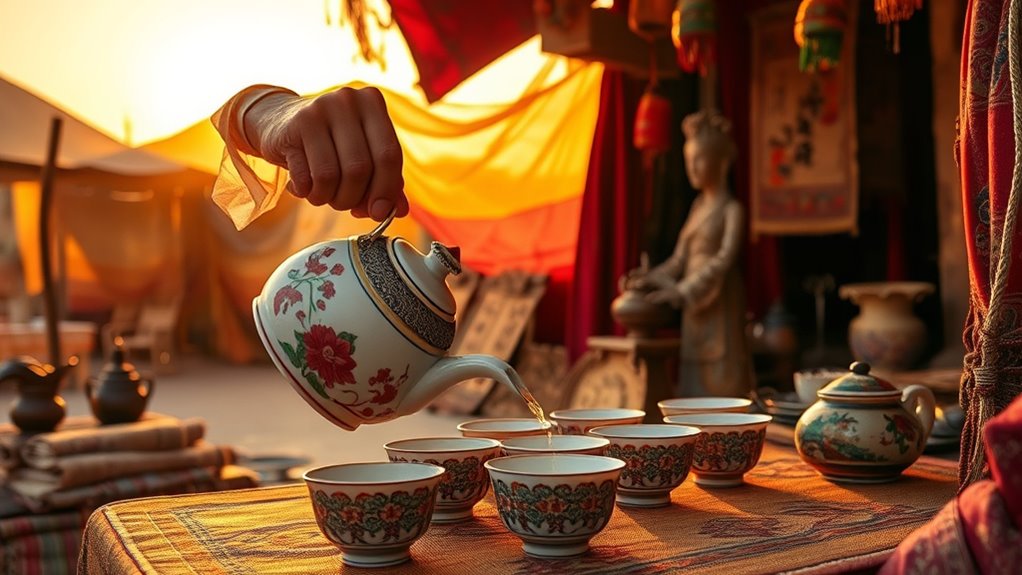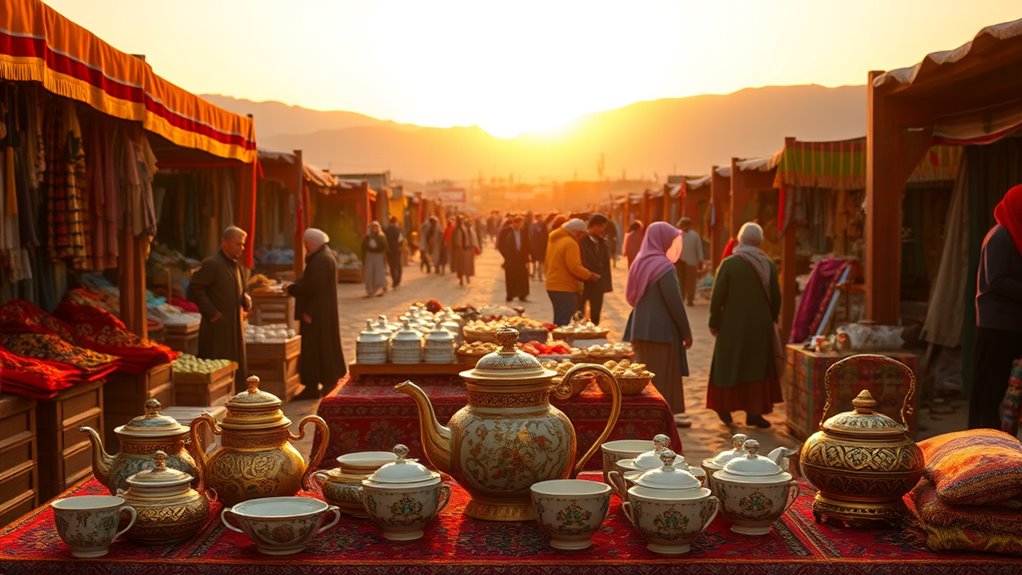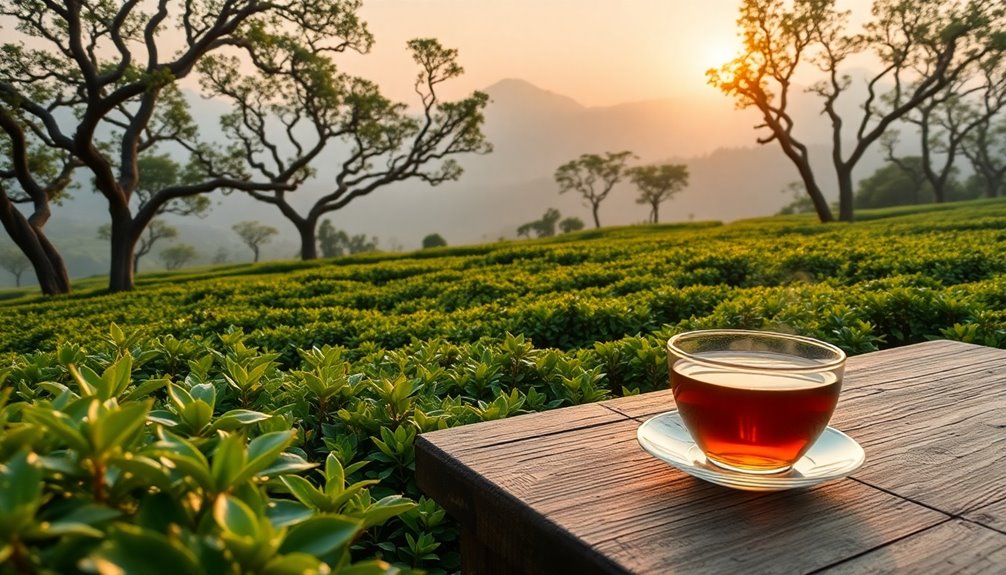Tea played a vital role in the Silk Road’s cultural exchange, turning from a simple drink into a symbol of friendship and tradition across many regions. As merchants transported tea, they shared more than leaves—they spread customs, ceremonies, and artistry that shaped local habits. Markets became vibrant hubs of ideas, blending Chinese roots with local practices. If you want to discover how tea’s journey fostered connections across continents, there’s more to uncover beyond these stories.
Key Takeaways
- Tea served as a cultural gift, fostering friendships and social bonds along Silk Road trade routes.
- Sharing tea customs and brewing techniques facilitated cross-cultural knowledge exchange.
- Markets along the Silk Road became hubs where tea influenced local traditions and styles.
- Tea’s role in rituals and ceremonies symbolized mutual respect and cultural understanding.
- The spread of tea contributed to artistic development, blending traditions and creating diverse regional tea cultures.

Have you ever wondered what hidden stories lie behind the ancient Silk Road? These trade routes weren’t just pathways for silk, spices, and precious metals; they also carried something more subtle yet incredibly influential—tea. As you explore the history of the Silk Road, you’ll see how tea cultivation played a essential role in fostering cultural exchange between East and West. Traders and travelers didn’t simply transport goods; they also carried ideas, traditions, and customs, many of which centered around tea.
Tea’s journey along the trade routes began centuries ago, originating from China’s lush tea plantations. As merchants traversed the vast network of Silk Road paths, they introduced tea to diverse regions, transforming it from a local beverage into a symbol of hospitality and social ritual across continents. This wasn’t just about drinking; it was about sharing a cultural experience, a gesture of friendship, and a sign of sophistication. As tea spread westward, it influenced local customs, inspiring new brewing techniques and ceremonies that blended local traditions with Chinese roots.
Tea’s journey from China transformed local customs into global symbols of hospitality and cultural exchange.
The trade routes facilitated more than just the movement of tea leaves. They enabled the exchange of knowledge about tea cultivation, processing, and appreciation. For example, the techniques for growing high-quality tea and brewing it became valuable commodities in their own right, traded along with the leaves themselves. This exchange helped elevate tea from a simple plant to an art form, creating a shared cultural language that transcended borders.
You can imagine the bustling markets along these routes, where merchants from different regions gathered to trade tea along with silk and spices. These markets were melting pots of cultural influences, where ideas about tea drinking, etiquette, and ceremonies were exchanged and adapted. Over time, these interactions led to the development of unique regional styles—Japanese matcha, Indian chai, Russian samovar tea—that still influence how we enjoy tea today.
In essence, the Silk Road wasn’t just a network of trade routes; it was a conduit for cultural dialogue. Tea cultivation and trade helped shape this dialogue, turning a simple beverage into a powerful symbol of connection and shared humanity. Every cup you enjoy now has roots that trace back to those ancient pathways, where stories, traditions, and tastes blended across borders, forging bonds that continue to influence us.
Frequently Asked Questions
How Did Tea Cultivation Spread Along the Silk Road?
You might wonder how tea cultivation spread along the Silk Road expansion. As traders traveled, they exchanged not just goods but knowledge about tea cultivation techniques and tea plants themselves. This exchange helped introduce tea to new regions, fueling its popularity. Merchants and travelers carried tea seeds and leaves, adapting cultivation methods to local climates. This process fostered cultural exchange and made tea an integral part of many societies along the Silk Road.
What Are the Different Types of Tea Traded Historically?
Did you know over 1,500 tea varieties exist today? Historically, traders exchanged black, green, white, oolong, and pu-erh teas, each with unique flavors and preparation methods. These teas traveled along trade routes, spreading cultural traditions. The different types of tea, from the light, delicate white to the robust black, shaped culinary practices across regions. Exploring tea varieties and their preparation reveals fascinating cultural stories and shared history.
How Did Tea Influence Diplomatic Relations Between Cultures?
You see, tea diplomacy played a significant role in fostering cultural exchange between nations. By sharing tea, you create a peaceful, social environment that encourages dialogue and understanding. Historically, rulers exchanged tea as a symbol of goodwill, strengthening diplomatic ties. This cultural exchange through tea helped build trust, promote cooperation, and establish lasting relationships, making tea more than just a beverage—it became a tool for diplomacy and cultural connection.
Were There Any Tea Rituals Unique to Silk Road Regions?
Imagine a delicate dance where each step reveals a new tradition. In Silk Road regions, tea rituals are unique, like intricate tapestries woven over centuries. Tea brewing isn’t just about making a drink; it’s a ceremonial act that embodies respect and harmony. Ritual ceremonies vary—from China’s Gongfu tea ceremonies to Central Asia’s shared cups—each reflecting local culture and history, turning simple tea into a profound cultural expression.
How Did Tea Trade Impact Local Economies Along the Silk Road?
You can see that tea trade boosted local economies along the Silk Road by encouraging tea farming and trade. As demand grew, farmers expanded production, creating jobs and increasing economic growth in regions like China and Central Asia. The thriving tea markets attracted merchants and traders, fostering commerce and cultural exchange. Therefore, tea trade played a significant role in strengthening local economies and connecting diverse cultures along the historic trade routes.
Conclusion
As you journey along the Silk Road, remember that tea isn’t just a warm drink; it’s a delicate bridge weaving cultures together like intricate threads in a vibrant tapestry. With every sip, you taste centuries of stories, traditions, and shared dreams. So, next time you brew a cup, imagine yourself sipping through time, uncovering hidden secrets and connecting worlds—one fragrant leaf at a time. Let tea be your passport to a rich tapestry of cultural exchange.










